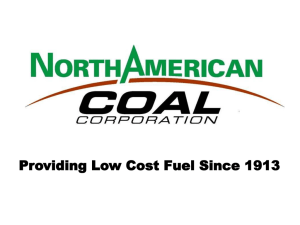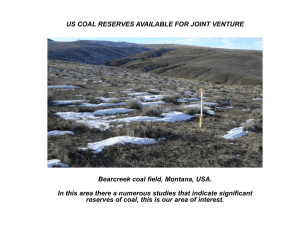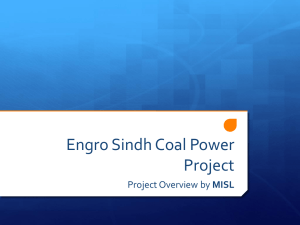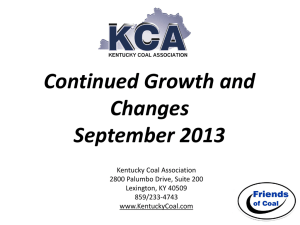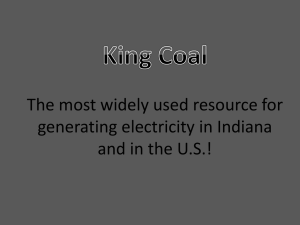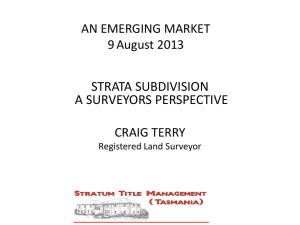Risk Assessment
advertisement
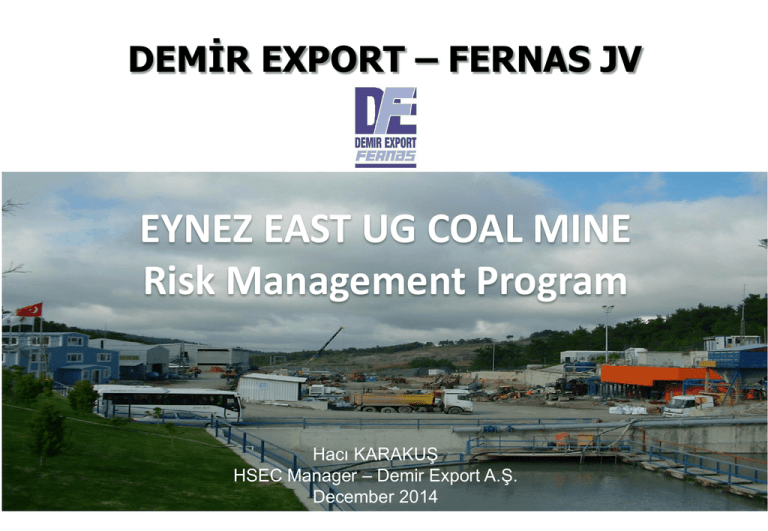
DEMİR EXPORT – FERNAS JV EYNEZ EAST UG COAL MINE Risk Management Program Hacı KARAKUŞ HSEC Manager – Demir Export A.Ş. December 2014 Contents Eynez East Coal Mine Introduction Risk Assesment Methodology Major Hazards High Risk Areas Risk Treatment Plan Conclusion Introduction East Eynez Coal Mine Eynez East UG Coal Mine is located in the vicinity of Eynez village, 35 km South of Soma; 106 km North of Manisa City. Eynez East is on the TKI concession of Soma Basin. Demir Export – Fernas JV (DEF) to all required surface and underground facilities to produce 2.5 million tonnes per year over 16 years of mine life. Coal seam is 22-29 thick, brown coal (lignite) 3 Introduction East Eynez Coal Project was tendered out by Turkish Coal Enterprises (TKI) in 2011. DEF started field work in May 2012. Project Schedule: 2012-2015 : Mine Development Period 2015-2016 : Start-up and ramp up period (1.5 Mtpa) 2016-2030 : Full production (2.5 Mtpa) Selected Mining Method: Longwall Top Coal Caving for safety and production capacity 4 Introduction 45 exploration drillholes were done by MTA for TKI. In addition DEF have done 8 more drillholes to develop 3D resource model for mine design and planning purposes. Open Pit Mine (TKI) New drillholes were drilled; • To improve coal reserve • To validate the formations Drillholes Locations Pillar (to protect Village) Eynez Village • Collect geotechnical data • Collect data for gas content • Detailed mine plan 5 Infrastructure Coal Blocks Production Panels Main Gallery Ventilation Gallery 6 Infrastructure Fully mechanized longwall top coal caving mining method (LTCC) 7 Infrastructure Coal and Personnel Transportation • Coal will be transported to surface through belt conveyors. All belt conveyors convey to international coal mining standards ,1200 mm wide and flame proof. Main haulage belt is steeel supported while others are solid woven belts. • People who work in the mine and equipments mainly transported to work areas through mono rail system. 8 Infrastructure Linear Development • 13 production panels will be mined out over life of mine, for all panels total maingate and tailgate roadways will reach 45.000 meters through LoM. • Advance of the ventilation drift is 1716 m, by mid of Nov. 2014 • Advance of the main haulage drift is 1580 m, by mid of Nov. 2014 9 Mining Method Longwall Top Coal Caving Method: Each coal level is divided into two sections (upper and lower excavation section) The lower section is 3,5 m high and secured by the hydraulic support system, coal is produced by shearer. The upper section 5 to 10 m in height, is exposed to dynamic stress conditions due to crumbling of the coal layer. To sum up, 70% of Coal production will be provided by free-falling and 30% by shearing. 10 Mining Method WHY LTCC? Mine Safety • Lower face heights result in improved face control, smaller and less expensive equipment and improved spontaneous combustion control in thick seams, through removal of the majority of top coal from the goaf. Resource Recovery and Mine Financial performance • The LTCC method enables extracting up to 90% of seams in the thick coal seams. Operating Cost • Since only 30% of coal is cut and the rest is free caving coal, operating cost for LTCC is typically lower than classical longwall operation. 11 Longwall Equipment Production equipment • Shearer • Hydraulic Shield Support • Front AFC (armoured face conveyor) • Rear AFC Hydraulic Shield Support 12 Equipment Haulage and Transport Equipment • Conveyors • Armored Chain Conveyor • Belt Conveyor • Monorail • Diesel Monorail • Shunting Trolley Belt Conveyor Chain Conveyor Monorail 13 Equipment Face/drift Development Equipment • Roadheader • Tunnel heading and loading machine Roadheader Tunnel Heading and Loading Machine 14 Risk Assessment • The site team have carried out a Broad Brush Risk Review (BBRR) for Eynez East Underground Coal Mine. The key objectives of the BBRR are to : 1. Identify the groups of major hazards those require detailed risk assesment by using bow tie analysis method. 2. Confirm the qualitative risk priority and 3. Provide a list of hazards that engineering and safety personel can review to ensure there are currently policies, procedures and strategies in place to control these hazards. 15 Risk Assessment The Bow Tie method is used extensively in hazardous industries Forms the basis of the risk assessment Focus is on: What can go wrong and why? Causes/Threats/Hazards How do we prevent it? Preventative Controls If we do lose control, how do we limit the effects Reactive Controls A Bow Tie model is developed for all the identified “major hazards” which includes specific hazards for the Eynez East Underground mine under Enyez Village 16 Risk Assessment Causes/ Threats Hazard 1 Hazard 2 Preventative Controls Reactive Controls Loss of Control Outcomes Near Miss Minor Loss Hazard 3 Hazard 4 Major Loss Hazard 5 Catastrophic The focus is on the hazards and controls 17 Risk Assessment Causes/ Threats Gas Preventative Controls Reactive Controls Near Miss Gas Drainage Gas monitors Electrical Equipment Failure Ex Rated Equipment Equipment maintenance Outcomes Gas About to Ignite Auto shut down of equipment Minor Loss Withdraw personnel Major Loss Emergency Response Catastrophic Everyone has responsibilities for the controls not just Safety people 18 Risk Assessment By its definition, major hazards have the potential, if not controlled effectively, to result in catastrophic outcomes therefore all are considered high risk (high consequence even if the likelihood is very low) and therefore all require detailed analysis to develop risk treatment plans to reduce the risk to ALARP (As Low As Reasonably Practicably). Team workshops were then conducted on the high risk areas, Major Hazard = those hazards which have very high consequence (eg) multiple fatalities or significant loss (immediate or over time) 22 major hazard groups were identified. 19 Introduction The top 10 Major Hazard groups were identified for review process are: 1. 2. 3. 4. 5. 6. 7. 8. 9. 10. Spontaneous Combustion Strata Instability Gas Explosion Entanglement, Conveyors, Caught in and Struck By Equipment Inrush / Inundation Emergency Response Electricity Carbon Monoxide (CO) / Gas Asphyxiation / Atmospheric Contaminants Underground fire Airblast 20 Risk Assessment • The residual risk of spon com, gas explosion, and strata failure are still high because the level of consequence is still extreme should an unwanted event occur. Risk level can be reduced through the effective implementation, monitoring and review of the risk treatment plan. Managing the controls at all times is critical during operation. • The Risk Treatment Plan (RTP) for spon com, strata and gas explosion was the starting point only and it is reviewed and updated by technical specialists with more information obtained and analyzed. The plan is based on the input from the team members with the information and understanding of the risks at the time. This may require review and change in the future if required. 21 Risk Assessment • Strata instability / failure : • The team identified and defined 15 hazards that need careful consideration by technical personnel and specific controls. Additional recommendations were made to improve the adequacy of the current and planned controls. Critical controls included development of ; • • • • Strata Control Management Plan, Cave Management Plan, Subsidence Management Plan, and An effective mine design, 22 Risk Assessment Mining affects on Eynez Village Subsidence and strata affects Vibration Water loss or impact on water quality Pillar (to protect Village) Eynez Village 23 Risk Assessment Mining near to or underneath an operational open cut mine Water inrush if flooded Blasting Pillar and strata issues Open Pit Mine (TKI) 24 Risk Assessment Mining next to old underground workings Water inrush if flooded Pillar and strata issues 25 Risk Assessment Mining through faults Pathways for water and gas Pillar and strata issues Longwall operations difficult (eg) slow advance which leads to deteriorating strata conditions in gate/tail roads 26 Risk Assessment Mining in thick seam and use of LTCC Caving issues (eg) mudrush (fines and water in goaf / cave zone) Pillar and strata issues Longwall operations difficult Spon com 27 Risk Assessment Gas – high gas concentrations Gas explosion Effects on strata instability (eg) coal outbursts Asphyxiation Lower coal seam interconnectivity and through faults Fire Carbon Monoxide Effects on ventilation flows Spontaneous Combustion The coal has a high propensity for spon com Goafs CO inflows to other areas 28 Risk Assessment Additional controls were developed throughout the hazard identification section of the risk assessment with a focus on the hierarchy of controls as depicted in the figure below. Hierarchy of Controls 1. Eliminate the Hazard 2. Substitute / Minimise 3. Engineering Control Redesign Enclose Isolate 4. System Controls Safe Work Procedures Training Warning Devices 5. PPE (last line of defence) 29 Conclusions At Eynez East Coal Mine three major hazard groups were identified. DEF internal control procedures and applications are developed. DEF Team suitably being trained. DEF Management Commitment, DE vision covers these major risks DE Safety Management Plan and applications covers the risks. Outside Services and Studies for Spon Com, Strata and Gas explosion Purchasing fit for purpose systems to reduce the impact of risks. Continuous training, monitoring and auditing. Reporting all incidents and accidents. Proactive HS applications. 30 THANK YOU 31


